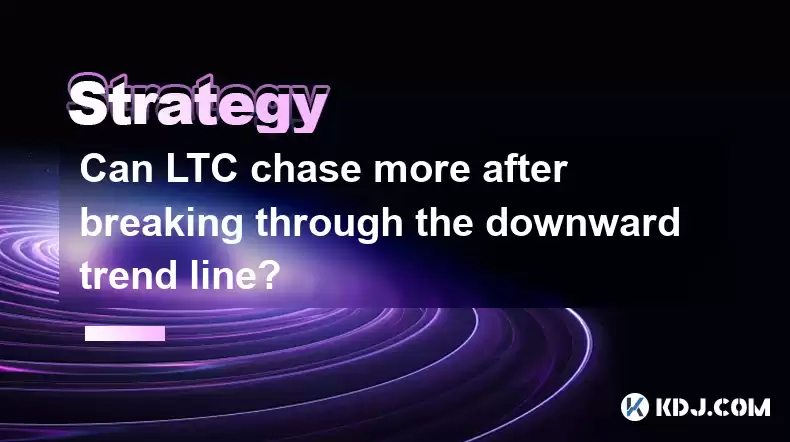-
 bitcoin
bitcoin $108842.957301 USD
-1.88% -
 ethereum
ethereum $3931.777121 USD
-1.66% -
 tether
tether $1.000186 USD
-0.03% -
 bnb
bnb $1153.250882 USD
-2.20% -
 xrp
xrp $2.367904 USD
-1.94% -
 solana
solana $186.182050 USD
-4.20% -
 usd-coin
usd-coin $0.999997 USD
0.00% -
 tron
tron $0.316949 USD
-1.00% -
 dogecoin
dogecoin $0.190780 USD
-3.12% -
 cardano
cardano $0.651324 USD
-2.67% -
 hyperliquid
hyperliquid $37.141055 USD
-0.85% -
 ethena-usde
ethena-usde $0.999224 USD
-0.09% -
 chainlink
chainlink $17.579031 USD
-2.47% -
 bitcoin-cash
bitcoin-cash $509.426284 USD
-2.79% -
 stellar
stellar $0.315298 USD
-2.93%
Can LTC chase more after breaking through the downward trend line?
Litecoin, created in 2011 by Charlie Lee, may chase higher prices after breaking a downward trend line, influenced by market sentiment and trading volume.
Apr 25, 2025 at 10:01 pm

Introduction to Litecoin (LTC)
Litecoin (LTC), often referred to as the silver to Bitcoin's gold, is a decentralized cryptocurrency that was created in 2011 by Charlie Lee, a former Google engineer. It is based on an open-source global payment network that is not controlled by any central authority. LTC aims to provide fast, secure, and low-cost payments by leveraging blockchain technology. The coin has gained significant attention in the cryptocurrency community due to its similarities to Bitcoin but with several technical improvements, such as faster block generation times and a different hashing algorithm.
Understanding the Downward Trend Line
In technical analysis, a downward trend line is drawn by connecting the highs of a price chart, indicating that the price is generally decreasing over time. When a cryptocurrency like LTC breaks through this line, it is often seen as a bullish signal, suggesting that the downward momentum may be weakening and that a potential reversal or uptrend might be on the horizon. Breaking through a downward trend line can attract more buyers, leading to increased buying pressure and potentially higher prices.
Factors Influencing LTC's Price Movement
Several factors can influence whether LTC will continue to chase higher prices after breaking through a downward trend line. Market sentiment plays a crucial role, as positive news and developments can boost investor confidence. Trading volume is another important factor; higher volumes accompanying the breakout can confirm the strength of the move. Additionally, technical indicators such as the Relative Strength Index (RSI) and Moving Averages can provide further insights into whether the momentum is likely to continue.
Historical Performance of LTC After Breakouts
Historically, LTC has shown varied performance following breakouts from downward trend lines. In some instances, the breakout has led to significant rallies, with the price continuing to climb as more investors jumped on the bandwagon. In other cases, the breakout was followed by a period of consolidation or even a reversal back into the previous downtrend. Studying past breakout events can provide valuable insights into potential future movements, although past performance is not indicative of future results.
Analyzing the Current Market Conditions
To determine if LTC is likely to chase higher after breaking through a downward trend line, it's essential to analyze the current market conditions. The overall cryptocurrency market sentiment can significantly impact LTC's performance. If the market is bullish, with major cryptocurrencies like Bitcoin showing strong gains, LTC is more likely to follow suit. Regulatory news and technological developments specific to Litecoin can also play a crucial role. For instance, updates to the Litecoin network or partnerships with major companies can boost investor confidence and drive the price higher.
Technical Analysis Tools for Predicting LTC's Movement
Technical analysis tools can be invaluable in predicting whether LTC will continue to rise after breaking through a downward trend line. Moving Averages can help identify the overall trend direction; if the price is above key moving averages like the 50-day or 200-day MA, it may indicate a stronger bullish trend. The Relative Strength Index (RSI) can indicate whether LTC is overbought or oversold, providing clues about potential reversals. Volume analysis is also crucial; a breakout accompanied by high volume is generally more reliable than one with low volume.
Trading Strategies for LTC After a Breakout
Traders can employ various strategies to capitalize on LTC's potential to chase higher after breaking through a downward trend line. One common approach is to enter a long position once the breakout is confirmed, setting a stop-loss order just below the trend line to manage risk. Another strategy involves waiting for a pullback to the broken trend line, which can now act as support, before entering a long position. This approach can provide a better entry price and potentially higher reward-to-risk ratio.
Risk Management and Position Sizing
Effective risk management is crucial when trading LTC or any cryptocurrency. Position sizing is a key aspect of risk management; traders should only risk a small percentage of their total capital on any single trade. Setting stop-loss orders can help limit potential losses if the breakout fails and the price reverses. Additionally, diversifying across different cryptocurrencies can reduce the impact of a single asset's poor performance on the overall portfolio.
Monitoring LTC's Performance Post-Breakout
After entering a trade based on LTC's breakout from a downward trend line, it's important to monitor the coin's performance closely. Price action around key levels such as previous resistance turned support can provide insights into the strength of the breakout. Volume should also be monitored; a sustained increase in volume can confirm the breakout's validity. News and developments related to Litecoin should be tracked, as they can impact the coin's price significantly.
Frequently Asked Questions
Q: How can I identify a valid breakout in LTC's price chart?A: To identify a valid breakout, look for a clear and decisive move above the downward trend line, accompanied by a significant increase in trading volume. Additionally, confirm the breakout with other technical indicators such as the RSI and moving averages.
Q: What are the potential risks of trading LTC after a breakout?A: The main risks include the possibility of a false breakout, where the price briefly moves above the trend line but then reverses back into the downtrend. Additionally, market volatility and unexpected news can lead to sharp price movements, potentially resulting in losses.
Q: Can fundamental analysis complement technical analysis when trading LTC?A: Yes, fundamental analysis can provide valuable insights into LTC's long-term potential. Factors such as network growth, adoption rates, and technological advancements can complement technical analysis and help traders make more informed decisions.
Q: How often should I review my LTC trading positions after a breakout?A: It's advisable to review your positions regularly, ideally daily or even more frequently during periods of high volatility. Monitoring price action, volume, and relevant news can help you adjust your strategy as needed and manage your risk effectively.
Disclaimer:info@kdj.com
The information provided is not trading advice. kdj.com does not assume any responsibility for any investments made based on the information provided in this article. Cryptocurrencies are highly volatile and it is highly recommended that you invest with caution after thorough research!
If you believe that the content used on this website infringes your copyright, please contact us immediately (info@kdj.com) and we will delete it promptly.
- BNB & BSC: Riding the Bull Run with Strong Support
- 2025-10-18 04:25:12
- Altcoins in the Spotlight: Solana, Ethereum, and the Rise of AlphaPepe
- 2025-10-18 04:25:12
- Crypto Opportunities: Investing in SHIB and TAP for Potential Gains
- 2025-10-18 04:30:13
- XRP's Wild Ride: ETF Delays and Price Drop – What's a Crypto New Yorker to Do?
- 2025-10-18 05:05:13
- Shiba Inu and the Quest for Crypto's Highest Gains: What's Next?
- 2025-10-18 04:30:13
- Midnight, Hydra Layer 2, and the NIGHT Token: A New Dawn for Cardano?
- 2025-10-18 04:45:14
Related knowledge

Practical parameter settings for a Bitcoin multi-timeframe moving average system
Sep 18,2025 at 10:54pm
Optimizing Timeframe Combinations for Bitcoin Trading1. Selecting appropriate timeframes is crucial when building a multi-timeframe moving average sys...

How can I filter out false breakouts in Dogecoin high-frequency trading?
Sep 22,2025 at 01:00am
Understanding False Breakouts in Dogecoin Trading1. A false breakout occurs when Dogecoin's price appears to move beyond a defined support or resistan...

Techniques for identifying tops and bottoms in the Bitcoin on-chain NVT model
Sep 20,2025 at 07:54pm
Understanding the NVT Model in Bitcoin Analysis1. The Network Value to Transactions (NVT) ratio is often described as the 'P/E ratio' of the cryptocur...

What does the surge in open interest in Bitcoincoin futures mean?
Sep 20,2025 at 11:18pm
Understanding the Surge in Dogecoin Futures Open Interest1. A surge in open interest within Dogecoin futures indicates a growing number of active cont...

How can I use the Ethereum USDT premium to gauge market sentiment?
Sep 18,2025 at 11:55pm
Understanding the Ethereum USDT Premium1. The Ethereum USDT premium refers to the price difference between USDT (Tether) traded on Ethereum-based plat...

What should I do if Ethereum staking yields decline?
Sep 20,2025 at 06:18am
Understanding the Causes Behind Declining Ethereum Staking Yields1. The Ethereum network transitioned to a proof-of-stake consensus mechanism with the...

Practical parameter settings for a Bitcoin multi-timeframe moving average system
Sep 18,2025 at 10:54pm
Optimizing Timeframe Combinations for Bitcoin Trading1. Selecting appropriate timeframes is crucial when building a multi-timeframe moving average sys...

How can I filter out false breakouts in Dogecoin high-frequency trading?
Sep 22,2025 at 01:00am
Understanding False Breakouts in Dogecoin Trading1. A false breakout occurs when Dogecoin's price appears to move beyond a defined support or resistan...

Techniques for identifying tops and bottoms in the Bitcoin on-chain NVT model
Sep 20,2025 at 07:54pm
Understanding the NVT Model in Bitcoin Analysis1. The Network Value to Transactions (NVT) ratio is often described as the 'P/E ratio' of the cryptocur...

What does the surge in open interest in Bitcoincoin futures mean?
Sep 20,2025 at 11:18pm
Understanding the Surge in Dogecoin Futures Open Interest1. A surge in open interest within Dogecoin futures indicates a growing number of active cont...

How can I use the Ethereum USDT premium to gauge market sentiment?
Sep 18,2025 at 11:55pm
Understanding the Ethereum USDT Premium1. The Ethereum USDT premium refers to the price difference between USDT (Tether) traded on Ethereum-based plat...

What should I do if Ethereum staking yields decline?
Sep 20,2025 at 06:18am
Understanding the Causes Behind Declining Ethereum Staking Yields1. The Ethereum network transitioned to a proof-of-stake consensus mechanism with the...
See all articles










































































